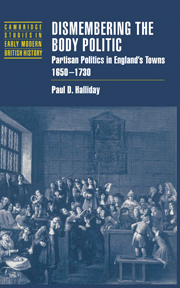Book contents
- Frontmatter
- Contents
- Preface
- List of abbreviations
- Part one Corporate ideal and partisan reality
- 1 The paradox of partisan politics
- 2 “The best of polities”
- 3 From purge to purge: Civil War, Interregnum, and Restoration in the corporations
- 4 Partisan politics, 1663–1682
- Part two The King and his corporations, 1660–1688
- Part three Partisan conflict and the law in a dynamic society
- Appendix A Royal charters of incorporation, 1660–1727
- Appendix B Enforcement of the Corporation Act, 1662–1663
- Select bibliography
- Index
- Titles in the series
4 - Partisan politics, 1663–1682
Published online by Cambridge University Press: 10 November 2009
- Frontmatter
- Contents
- Preface
- List of abbreviations
- Part one Corporate ideal and partisan reality
- 1 The paradox of partisan politics
- 2 “The best of polities”
- 3 From purge to purge: Civil War, Interregnum, and Restoration in the corporations
- 4 Partisan politics, 1663–1682
- Part two The King and his corporations, 1660–1688
- Part three Partisan conflict and the law in a dynamic society
- Appendix A Royal charters of incorporation, 1660–1727
- Appendix B Enforcement of the Corporation Act, 1662–1663
- Select bibliography
- Index
- Titles in the series
Summary
The Corporation Act left behind two groups in Northampton: the corporation and a disgruntled rump expelled from it. In March of 1663, the third parliamentary by-election in eighteen months set the corporation against “the secluded members.” Mayor John Brafield's choice, Sir William Dudley, challenged Christopher Hatton. Hatton won with the help of those expelled. The “secluded members” showed elsewhere that their political vigor remained as they attacked Brafield and his corporate friends with law suits. Within the corporation, the political weight began to shift with the choice of William Vaughan – a foe of Brafield – as mayor and Vaughan's allies as JPs and coroners. But March 1664 brought another by-election. This time, ardent Anglican Sir John Yelverton prevailed against Vaughan's candidate, Sir John Bernard. So Vaughan, to shore up his damaged base, tried to expel Yelverton's supporters from the corporation but was prevented by a letter from the King, sent in response to pleas to help “the loyal party.”
The electoral struggle of 1663 set the corporation against those excised from it, but in 1664, the corporation began dividing within as partisans of those left out tried to expel their foes and to restore their ousted friends. The center of political gravity then shifted again as Francis Pickmer, “loyal” Brafield's ally, followed Vaughan as mayor in 1664. Tradition dictated that when Pickmer's year ended, he should preside at his successor's election. But Pickmer left town on the appointed day, aware that “the house [had] crossed him in his design of choosing a man he intended”.
- Type
- Chapter
- Information
- Dismembering the Body PoliticPartisan Politics in England's Towns, 1650–1730, pp. 106 - 146Publisher: Cambridge University PressPrint publication year: 1998



